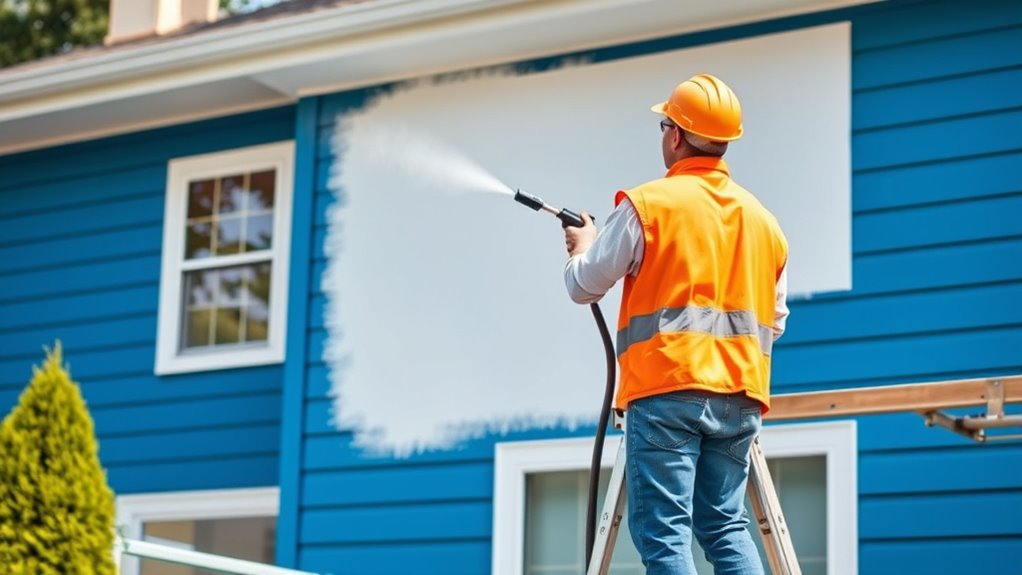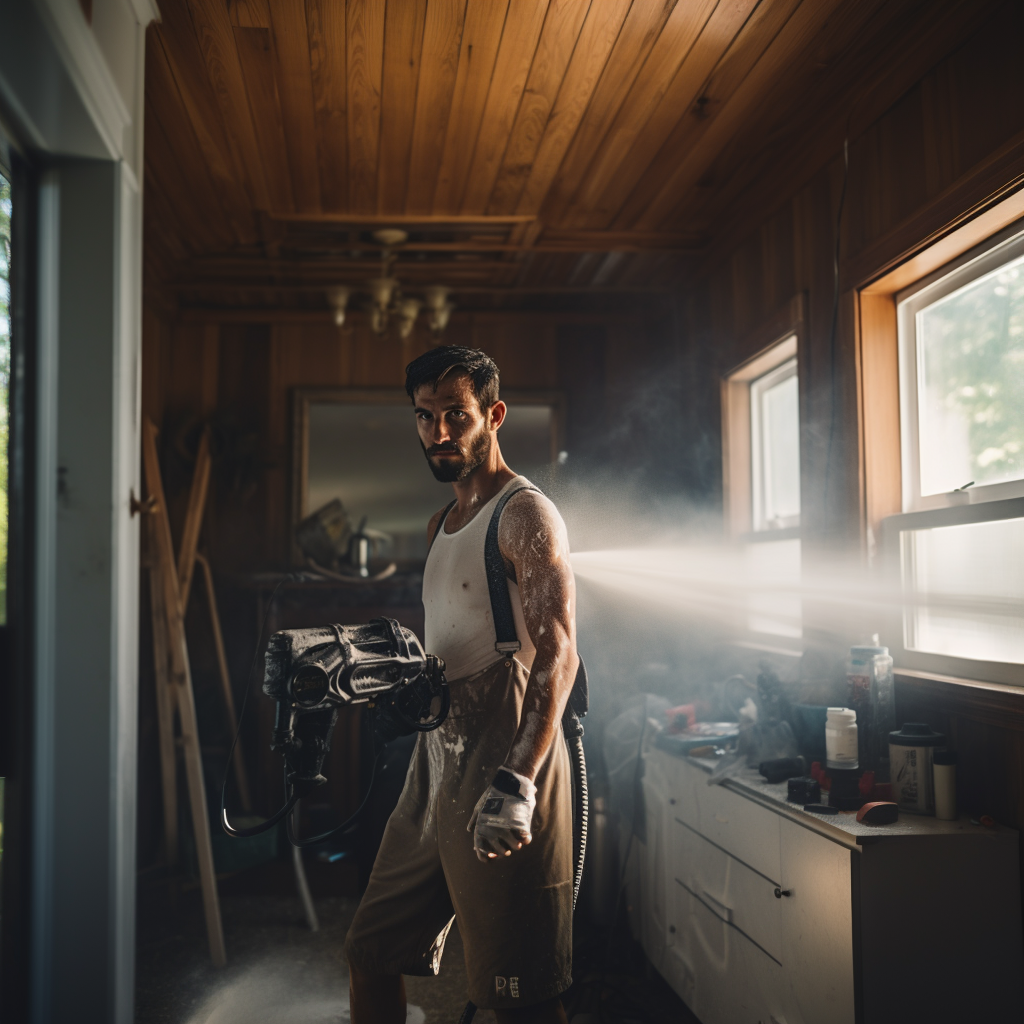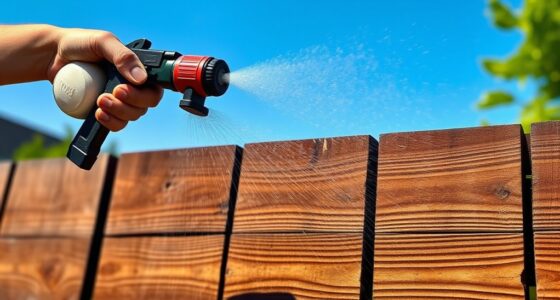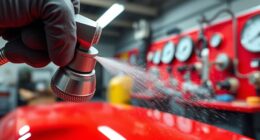To spray a two-story house exterior safely and efficiently, start by wearing proper safety gear like goggles, masks, and gloves. Prepare the surface by cleaning and repairing any issues, and use a steady, overlapping spray technique from top to bottom, keeping the nozzle 12-18 inches away. Keep equipment clean and manage external conditions like wind. Working systematically guarantees a smooth finish; for detailed tips, continue exploring practical steps to master the process.
Key Takeaways
- Use scaffolding or extension poles to safely access two-story exterior surfaces.
- Wear full safety gear, including goggles, respirator, gloves, and protective clothing throughout the project.
- Maintain a consistent spray distance of 12-18 inches and use steady, overlapping passes for even coverage.
- Work systematically from top to bottom, planning your route to avoid stepping over wet paint.
- Regularly check and maintain equipment, and be mindful of wind to prevent overspray and ensure safety.
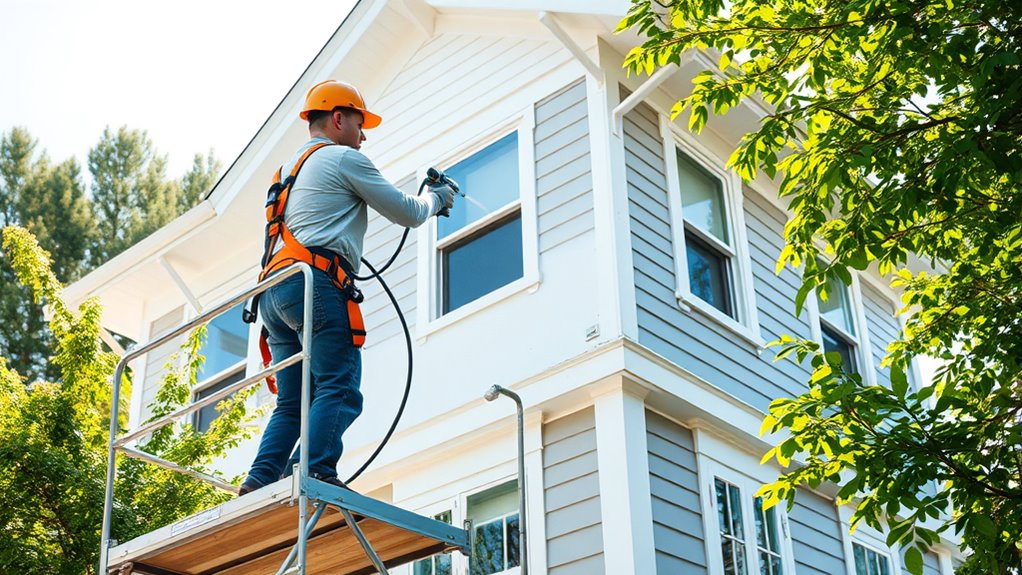
Spraying a two-story house exterior can be a manageable project if you plan carefully and use the right equipment. Before you begin, ensure you have all necessary safety gear, including goggles, a mask or respirator, gloves, and protective clothing. Safety gear is vital because it protects you from paint fumes, overspray, and potential debris. Proper protection allows you to work confidently and reduces the risk of accidents or health issues. Once equipped, assess the house’s surface to identify any areas needing repairs or special attention. This preparatory step helps guarantee a smooth spraying process and a clean finish.
Next, focus on mastering your spray technique. A consistent, even spray is key to achieving a professional look, especially on a two-story house where uneven coverage is more noticeable. Keep the spray nozzle about 12 to 18 inches from the surface and move steadily in smooth, overlapping passes. Maintain a consistent speed; going too fast can lead to thin coverage, while moving too slow increases the chance of drips and runs. Practice your spray technique on a scrap piece or an inconspicuous area first to get a feel for the equipment and guarantee your pattern is even. Use a back-and-forth motion, slightly overlapping each pass to prevent streaks or missed spots. Be mindful of the wind, as it can affect spray direction and cause overspray, which can land on unintended surfaces or your equipment.
When working on higher areas of the house, consider using an extension pole or a scaffolding system designed for painting. These tools enable you to reach the upper sections safely without overextending or risking a fall. Always keep your footing stable and avoid leaning too far or overreaching, as accidents happen quickly when balance is compromised. When moving around the house, plan your route to minimize walking over freshly sprayed areas, which can smudge the finish. Take your time and work systematically, starting from the top and working downward to prevent drips from settling on already painted sections.
Throughout the project, regularly check your equipment for clogs or uneven spray patterns and clean or adjust as needed. Proper spray technique combined with comprehensive safety gear will ensure your project not only looks great but also keeps you safe. Remember, patience and preparation are your best tools for spraying a two-story house exterior efficiently and safely.
Frequently Asked Questions
What Safety Gear Is Essential for Spraying a Two-Story House?
When spraying a two-story house, you need essential safety gear to protect yourself. Always use ladder safety techniques to prevent falls, ensuring your ladder is stable and secure. Wear protective clothing, including gloves, goggles, and a respirator, to shield your skin and eyes from paint and fumes. This gear helps you stay safe and comfortable while working at heights, making your project safer and more efficient.
How Do I Choose the Right Type of Paint for Exterior Spraying?
Choosing the right paint is like picking the perfect outfit for a special occasion—you want it to stand out and last. You should consider paint types, like acrylic or latex, for durability and ease of application. Think about finish options, such as matte, satin, or semi-gloss, to match your style and exposure. Select high-quality exterior paint that withstands weather, ensuring your house looks fantastic and stays protected for years.
Can I Spray a Two-Story House in Windy Weather?
You shouldn’t spray a two-story house in windy weather, as wind conditions can cause overspray and uneven coverage. High winds increase the risk of paint drifting and missing your target area, so it’s best to wait for calmer days. Maintain a consistent spray distance to ensure even application, and avoid spraying when wind speeds are too high, safeguarding both your work quality and safety.
How Do I Prevent Overspray on Nearby Plants and Surfaces?
Did you know overspray can reach up to 10 feet beyond your target area? To prevent this, start with plant protection by covering nearby greenery with plastic sheeting or drop cloths. Use surface masking tape on windows, trim, and surfaces you want to stay clean. Maintain a steady spray distance and controlled motion, ensuring overspray stays minimized, protecting your plants and surfaces from accidental paint or coating damage.
What Maintenance Is Required for Spray Equipment After Use?
After finishing, you need to perform equipment cleaning to prevent paint buildup and corrosion, ensuring it stays in good condition. Follow proper storage procedures by thoroughly drying and storing your spray equipment in a cool, dry place away from direct sunlight. This maintenance helps extend the lifespan of your tools, keeps them ready for next use, and maintains excellent spraying performance. Regular upkeep is essential for safe, efficient future projects.
Conclusion
Remember, safety and preparation are your best allies when spraying a two-story house exterior. While many believe that experience alone guarantees perfect results, true mastery comes from respecting the process and understanding that even experts learn and adapt. Like any skill, it’s about continuous improvement and patience. By approaching the task thoughtfully, you not only protect yourself and your home but also embrace the idea that growth often comes through careful practice and reflection.
Franz came aboard the Paint Sprayer Zone team with a background in both journalism and home renovation. His articulate writing style, combined with a passion for DIY projects, makes him an invaluable asset. Franz has a knack for breaking down technical jargon into easy-to-understand content, ensuring that even the most novice of readers can grasp the complexities of paint sprayers.
